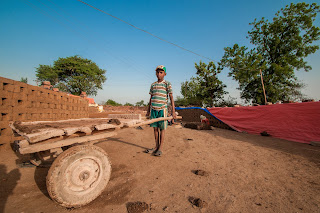End Child Labour: Guiding Children in the Right Direction
When my mother died I was very young,
And my father sold me while yet my tongue
Could scarcely cry "'weep! 'weep!
'weep! 'weep!"
So your chimneys I sweep & in soot I
sleep.
The figure of Chimney Sweeper in Blake’s poem is the emblem of the
exploitation of children in the Industrial Age. According to a report submitted to a
parliamentary committee on the employment of child sweeps in 1817, ‘the
climbing boys’ as young as four were sold by their parents to master-sweeps, or
recruited from workhouses. Inhumane practices like forcing pins into the
sweeps’ feet to encourage them to climb more quickly were prevalent.
One would expect this to be a historical practice. Alas!
Child labour is still very much prevalent in different forms around the world. According
to the 2011 Census, the number of child labourers in India is 10.1 million.
They can be found in a variety of industries including brick kilns, carpet weaving,
garment making, domestic service, food and refreshment services, agriculture,
fisheries and mining.
Child Labour-
Issues and Factors
The International Labour Organization (ILO) defines Child Labour as “work that deprives
children of their childhood, their potential and their dignity, and that is
harmful to physical and mental development.” It includes the work that is
mentally, physically, and morally dangerous for children and interferes with
their education.
Many factors such as poverty, unemployed family members,
migrations, and emergencies lead to child labour. Children belong in schools
but child labour deprives them of their right to education and encourages
intergenerational poverty. The policies on preventing child labour exist but
there is a lack of enforcement on the ground level.
Children work in both formal and informal sectors. Some
industries like bangle making, beedi making, firecracker, etc. are harmful as
they use toxic metals and substances such as lead, mercury, manganese,
chromium, cadmium, benzene, pesticides and asbestos which can have grave side
effects on children’s health.
Child labour can be prevented through integrated approaches
by addressing poverty and providing quality education. Other acts like economic
development, increasing awareness, affordable education, enforcement of child
labour laws, and reintegration of child workers into their homes and schools can
contribute to eradicating this social evil.
No Child Should be on Streets
Poverty is one of the major contributors to child labour as
children are either forced or exploited into working for a meagre amount of
money. While we wait for the change to happen on a larger level, we should
ensure that no child is on the streets as they are most susceptible to physical,
mental, and sexual exploitation outside the security of their homes.
Udayan Care provides the warmth and security of the family to
vulnerable and underprivileged children so that they don’t end up on the
streets. The Udayan Ghar Programme is a unique group-home model based on the
core concept of ‘Living In Family Environment’ or LIFE. These Ghars nurture the
Out-of-Homecare (OHC) children including orphans, abandoned or abused children.
Udayan Ghar is a home where children live in the care of a
compassionate family. A close-knit group of around 12 children aged 6 to 18
live as a unit in these group homes. It focuses on providing a secure home, good
education, nutritious food, excellent physical and mental health and plenty of growth
opportunities to the children.
What is remarkable about Udayan Ghar Programme is that it is
run by a committed team of caregivers including ‘Mentor Parents’ who are lifetime
volunteers dedicated to the cause of child protection and care. The team also
consists of professional social workers and other child or mental health care
professionals who work together to provide love, protection and guidance to the
children.
Such programs that focus on providing a family to vulnerable
children contribute to taking them off the streets, thereby, reducing their
chances of ending up as child labourers. These also inculcate a sense of
belonging among children and empower them to form healthy and safe
relationships in life. The values instilled in a family environment inspire children to make a positive difference in society
when they grow up.
Programs like Udayan Ghars can also prove instrumental in
achieving the Sustainable Development Goals laid by the UN General Assembly aiming
to eliminate child labour by 2025 (8.7) and end abuse, exploitation, trafficking and all forms of violence and torture against
children. While there is a need for effective strategies to mobilize
public support to end child labour, the initiatives like Udayan Ghars are the lighthouses
guiding the waves of vulnerable children in the right direction.




.jpg)
Comments
Post a Comment